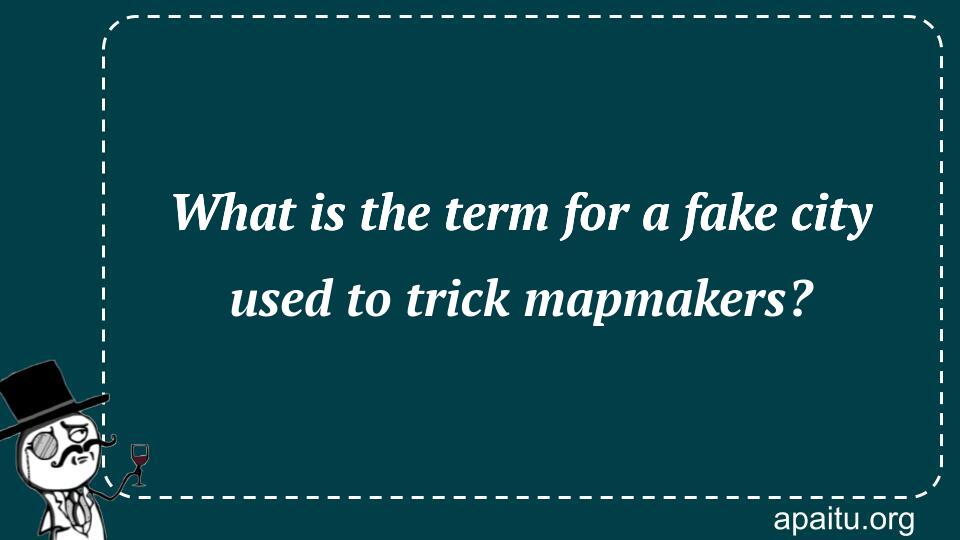Question
Here is the question : WHAT IS THE TERM FOR A FAKE CITY USED TO TRICK MAPMAKERS?
Option
Here is the option for the question :
- Turnaround Town
- Ghost Town
- Paper Town
- Trick City
The Answer:
And, the answer for the the question is :
Explanation:
Cartographers are a crafty bunch. In addition to measuring, analyzing, and accurately mapping difficult data, they also managed to have a little fun while doing it. Paper towns are made-up settlements that cartographers drew on their maps to deter others from plagiarizing their work. The widely read book “Paper Towns” by John Green, which features the paper town of Agloe, New York, raised awareness of these imaginary communities. To prevent others from stealing their work, some mapmakers have also employed “trap streets,” which are fictitious streets that have the same function as paper towns. Beatosu and Goblu in Ohio, Argleton in West Lancashire, England, and Mount Richard, a made-up mountain in Colorado, are examples of other paper towns.

In the fascinating world of cartography, where maps serve as our visual guides to the world, there exists a peculiar phenomenon known as a “paper town.” A paper town refers to a fictitious city or town deliberately created to deceive mapmakers and protect against copyright infringement. In this article, we delve into the intriguing concept of paper towns, exploring their history, purpose, and the curious relationship between cartography and deception.
Mapmaking is an intricate art form that requires precision, accuracy, and meticulous attention to detail. Mapmakers, also known as cartographers, strive to create maps that faithfully represent the geographic features of an area. However, in an age where information is readily accessible and intellectual property rights are fiercely protected, the need for mapmakers to safeguard their work has given rise to the concept of paper towns.
The term “paper town” originated from the practice of including fictitious towns or streets on maps as a form of copyright trap. These imaginary locations serve as a unique identifier, allowing mapmakers to identify instances of unauthorized copying or plagiarism. If a mapmaker comes across a map that includes these nonexistent places, it becomes evident that the work has been illicitly reproduced.
The creation of paper towns is not a recent phenomenon. It dates back centuries when maps were painstakingly hand-drawn and reproduced through printing presses. The inclusion of fictional towns served as a clever strategy to protect the cartographers’ intellectual property rights. These phantom locations were often strategically placed in areas of the map that were less likely to be scrutinized, such as remote regions or unpopulated areas.
One notable example of a paper town is the fictional town of Agloe, New York. In the 1930s, a map publishing company called General Drafting Company decided to include Agloe on their maps as a copyright trap. To their surprise, Agloe began to appear on other maps, perpetuating its existence as a “real” place. Eventually, a general store was even established at the supposed location of Agloe, further blurring the line between fiction and reality.
The advent of digital mapping technology has made it easier to detect and remove paper towns from maps. However, the practice of creating fictitious locations still persists in various forms. paper towns have also been used as a means of catching plagiarists or identifying copyright infringement in other creative works, such as books and music.
While the primary purpose of paper towns is to safeguard the work of mapmakers, they have also sparked curiosity and intrigue among map enthusiasts and researchers. The existence of these phantom locations raises questions about the reliability and authenticity of maps as representations of reality. It reminds us that maps, like any other form of human creation, can be subject to manipulation, deception, and hidden agendas.
The concept of paper towns underscores the complex relationship between cartography and truth. Maps, often seen as objective and factual representations of the world, are not immune to human fallibility or the influence of external factors. They reflect the knowledge, biases, and intentions of their creators, highlighting the subjective nature of mapmaking.
As we navigate the world using maps as our guides, it is important to recognize that they are not infallible. They are dynamic representations that evolve alongside our understanding of the world and the technology we employ to depict it. Paper towns serve as a reminder that even in the age of advanced mapping technologies, the potential for deception and the need for critical thinking persist.
paper towns are fictitious cities or towns intentionally included on maps to serve as copyright traps and protect the intellectual property of mapmakers. These phantom locations have a long history rooted in the art of mapmaking and continue to intrigue researchers and map enthusiasts. As we explore the world through the lens of maps, it is crucial to be aware of the complexities and potential for deception inherent in cartography.